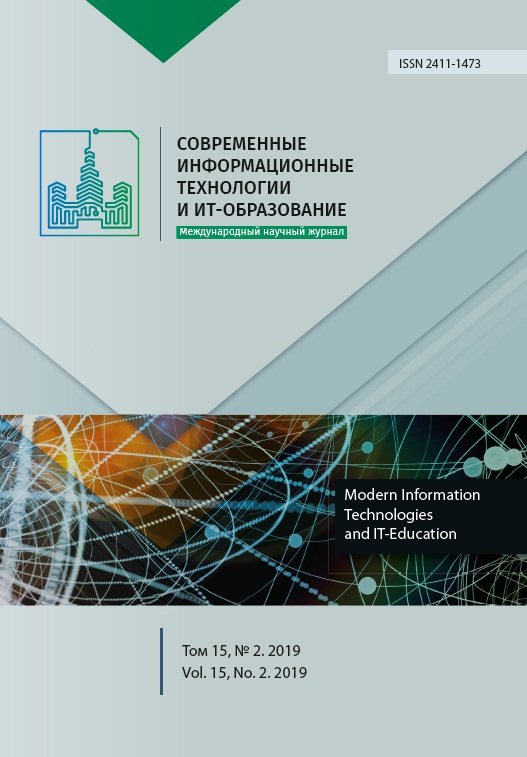Проектирование учебных материалов c использованием систем компьютерной математики
Аннотация
В работе описан метод проектирования иллюстративного материала, используемого при обучении студентов технического направления подготовки, с использованием систем компьютерной математики (Mathematica, Matlab, MatCad и др.). Обсуждаются его основные методические характеристики. Рассматриваемый метод отличают вариативность достигаемых целей обучения, персонифицированность процесса обучения, градация материалов по уровням освоения, возможность простого и быстрого создания дополнительных материалов, допустимость использования как для аудиторной, так и внеаудиторной работы. Данный метод используется авторами в Московском государственном техническом университете им. Н.Э. Баумана при подготовке студентов факультета «Специальное машиностроение». В качестве примера применения метода приведен код системы Mathematica, используемый для создания интерактивных учебных материалов по одной из тем, изучаемых в начале курса математической статистики, посвященный описанию и представлению выборочных данных.
Литература
[2] Thomas M.O.J. Teachers using computers in the mathematics classroom: A longitudinal study. In: Novotná J., Moraová H., Krátká M., Stehlíková N. (eds). Proceedings of the 30th Conference of the International Group for the Psychology of Mathematics Education. Prague, Czech Republic: Charles University. 2006; 5:265-272. Available at: https://www.emis.de/proceedings/PME30/5/265.pdf (accessed 10.05.2019). (In Eng.)
[3] Garner S. The CAS classroom. Australian Senior Mathematics Journal. 2004; 18(2):28-42. Available at: https://files.eric.ed.gov/fulltext/EJ720051.pdf (accessed 10.05.2019). (In Eng.)
[4] Kendal M., Stacey K. Teachers in transition: Moving towards CAS-supported classrooms. Zentralblatt für Didaktik der Mathematik. 2002; 34(5):196-203. (In Eng.) DOI: 10.1007/BF02655822
[5] Psycharis S. The Impact of computational experiment and formative assessment in inquiry-based teaching and learning approach in STEM education. Journal of Science Education and Technology. 2016; 25(2):316-326. (In Eng.) DOI: 10.1007/s10956-015-9595-z
[6] Rozanova S.A., Sanina E.I., Kuznetsova T.A. Didactic possibilities of the information and communication technologies in teaching mathematics in higher education institution. Vestnik Rossijskogo universiteta druzhby narodov. Seriya: Informatizaciya obrazovaniya = RUDN Journal of Informatization in Education. 2012; 3:93-98. Available at: https://elibrary.ru/item.asp?id=17927715 (accessed 10.05.2019). (In Russ., abstract in Eng.)
[7] Vlasova E.A., Popov V.S., Pugachev O.V. The Use of Electronic Mathematical Software in Teaching Mathematics. Vestnik Moskovskogo gosudarstvennogo oblastnogo universiteta. Seriya: Fizika-matematika = Bulletin of the Moscow Region State University. Series: Physics-Mathematics. 2016; 3:120-132. (In Russ., abstract in Eng.) DOI: 10.18384/2310-7251-2016-3-120-132
[8] Nortvedt G.A., Buchholtz N. Assessment in mathematics education: responding to issues regarding methodology, policy, and equity. ZDM Mathematics Education. 2018; 50(4):555-570. (In Eng.) DOI: 10.1007/s11858-018-0963-z
[9] Vlasova E.A., Mezhennaya N.M., Popov V.S., Pugachev O.V. The use of mathematical packages in the framework of methodological support of probabilistic disciplines in a technical university. Vestnik Moskovskogo gosudarstvennogo oblastnogo universiteta. Seriya: Fizika-matematika = Bulletin of Moscow Region State University. Series: Physics and Mathematics. 2017; 4:114-128. (In Russ., abstract in Eng.) DOI: 10.18384/2310-7251-2017-4-114-128
[10] Hoogland K., Pepin B., Bakker A., de Koning J., Gravemeijer K. Representing contextual mathematical problems in descriptive or depictive form: Design of an instrument and validation of its uses. Studies in Educational Evaluation. 2016; 50:22-32. (In Eng.) DOI: 10.1016/j.stueduc.2016.06.005
[11] Bokhove C., Drijvers P. Digital tools for algebra education: criteria and evaluation. International Journal of Computers for Mathematical Learning. 2010; 15(1):45-62. (In Eng.) DOI: 10.1007/s10758-010-9162-x
[12] Bano M., Zowghi D., Kearney M., Schuck S., Aubusson P. Mobile learning for science and mathematics school education: A systematic review of empirical evidence. Computers & Education. 2018; 121:30-58. (In Eng.) DOI: 10.1016/j.compedu.2018.02.006
[13] Geer R., White B., Zeegers Y., Au W., Barnes A. Emerging pedagogies for the use of iPads in schools. British Journal of Educational Technology. 2017; 48(2):490-498. (In Eng.) DOI: 10.1111/bjet.12381
[14] Rau M. A. Conditions for the effectiveness of multiple visual representations in enhancing STEM learning. Educational Psychology Review. 2017; 29(4):717-761. (In Eng.) DOI: 10.1007/s10648-016-9365-3
[15] Fu Q. K., Hwang G. J. Trends in mobile technology-supported collaborative learning: A systematic review of journal publications from 2007 to 2016. Computers & Education. 2018; 119:129-143. (In Eng.) DOI: 10.1016/j.compedu.2018.01.004
[16] Gueudet G., Pepin B. Didactic contract at the beginning of university: a focus on resources and their use. International Journal of Research in Undergraduate Mathematics Education. 2018; 4(1):56-73. (In Eng.) DOI: 10.1007/s40753-018-0069-6
[17] De Vita M., Verschaffel L., Jan E. Towards a better understanding of the potential of interactive whiteboards in stimulating mathematics learning. Learning Environments Research. 2018; 21(1):81-107. (In Eng.) DOI: 10.1007/s10984-017-9241-1
[18] Jones S.R., Watson K.L. Recommendations for a “Target Understanding” of the Derivative Concept for First Semester Calculus Teaching and Learning. International Journal of Research in Undergraduate Mathematics Education. 2018; 4(2):199-227. (In Eng.) DOI: 10.1007/s40753-017-0057-2
[19] Misfeldt M., Jankvist U.T. Instrumental genesis and proof: understanding the use of computer algebra systems in proofs in textbook. In: Ball L., Drijvers P., Ladel S., Siller H.S., Tabach M., Vale C. (eds). Uses of Technology in Primary and Secondary Mathematics Education. ICME-13 Monographs. Springer: Cham. 2018; 375-385. (In Eng.) DOI: 10.1007/978-3-319-76575-4_22
[20] Kidron I., Tall D. The roles of visualization and symbolism in the potential and actual infinity of the limit process. Educational Studies in Mathematics. 2015; 88(2):183-199. (In Eng.) DOI: 10.1007/s10649-014-9567-x
[21] Kramarski B., Hirsch C. Using computer algebra systems in mathematical classrooms. Journal of Computer Assisted Learning. 2003; 19(1):35-45. (In Eng.) DOI: 10.1046/j.0266-4909.2003.00004.x
[22] Hoogland K., Tout D. Computer-based assessment of mathematics into the twenty-first century: pressures and tensions. ZDM Mathematics Education. 2018; 50(4):675-686. (In Eng.) DOI: 10.1007/s11858-018-0944-2

Это произведение доступно по лицензии Creative Commons «Attribution» («Атрибуция») 4.0 Всемирная.
Редакционная политика журнала основывается на традиционных этических принципах российской научной периодики и строится с учетом этических норм работы редакторов и издателей, закрепленных в Кодексе поведения и руководящих принципах наилучшей практики для редактора журнала (Code of Conduct and Best Practice Guidelines for Journal Editors) и Кодексе поведения для издателя журнала (Code of Conduct for Journal Publishers), разработанных Комитетом по публикационной этике - Committee on Publication Ethics (COPE). В процессе издательской деятельности редколлегия журнала руководствуется международными правилами охраны авторского права, нормами действующего законодательства РФ, международными издательскими стандартами и обязательной ссылке на первоисточник.
Журнал позволяет авторам сохранять авторское право без ограничений. Журнал позволяет авторам сохранить права на публикацию без ограничений.
Издательская политика в области авторского права и архивирования определяются «зеленым цветом» в базе данных SHERPA/RoMEO.
Все статьи распространяются на условиях лицензии Creative Commons «Attribution» («Атрибуция») 4.0 Всемирная, которая позволяет другим использовать, распространять, дополнять эту работу с обязательной ссылкой на оригинальную работу и публикацию в этом журналe.













